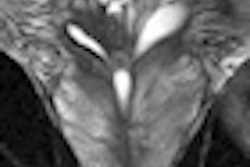Preoperative prostate MRI can help urologic surgeons spare the neurovascular bundle during robotic-assisted laparoscopic prostatectomy (RALP) in treating prostate cancer, according to a study presented at the American Roentgen Ray Society (ARRS) meeting this week in San Diego.
The finding by researchers at the University of California, Los Angeles is significant because the additional information provided by MRI can help compensate for a RALP shortfall and spare the neurovascular bundle, which controls male erectile function and continence.
While RALP is becoming increasingly common for treating prostate cancer, lead author Dr. Timothy McClure noted that the technique is limited by a lack of haptic feedback (sense of touch), which urologic surgeons need to evaluate the neurovascular bundle and determine if a nerve-sparing technique is possible. The lack of touch, the study noted, could lead to increased rates of positive surgical margins, which are associated with an increased risk of cancer recurrence.
The researchers reviewed data for 104 men with biopsy-proven prostate cancer who underwent preoperative endorectal prostate MRI prior to RALP. The 1.5-tesla MRI scans included T2- and diffusion-weighted imaging, dynamic contrast-enhanced imaging, and MR spectroscopy.
A surgeon then determined one preoperative plan using a patient's initial clinical information, and chose a second preoperative plan based on additional clinical information from the MRI scan.
Twenty-nine (27%) of the 104 patients had their nerve-sparing technique changed because of the MRI scans. Seventeen (58%) of those 29 patients underwent nerve-sparing surgery, while 12 (42%) patients received non-nerve-sparing surgery.
Seven (7%) of the 104 patients exhibited positive surgical margins, with six (87%) of the seven patients having no change in their operative plan based on MRI results. One (14%) of seven patients had a positive margin where MRI changed the operative plan to nerve-sparing surgery.
Among the patients who had their treatment changed to non-nerve-sparing techniques, no patients had positive surgical margins.
"MRI before RALP appears to help surgeons make a more informed decision with regards to the aggressiveness of nerve-sparing surgical technique without compromising the oncological outcome," McClure concluded.
By Wayne Forrest
AuntMinnie.com staff writer
May 6, 2010
Related Reading
MRI helps uncover use of deadly erectile dysfunction drug, February 25, 2009
Preservation of erectile function excellent after prostate brachytherapy, August 22, 2007
Early phosphodiesterase inhibitor use after brachytherapy aids erectile function, January 17, 2007
Sexual healing: Imaging takes a roll in the hay with human relations, April 29, 2004
Copyright © 2010 AuntMinnie.com



















